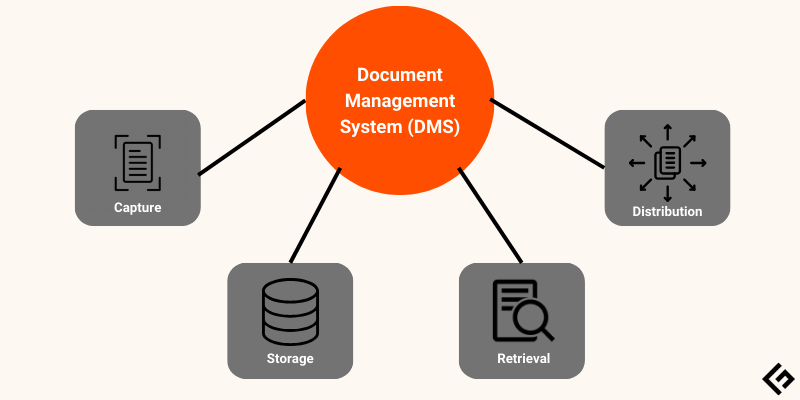We earn commission when you buy through affiliate links.
This does not influence our reviews or recommendations.Learn more.
Adocument management system(DMS) is a central hub for storing, organizing, and sharing digitized documents.

It streamlines digital workflows and empowers the workforce.
This article will explain different aspects of aDMSso that companies willing to switch to aDMScan make an informed decision.
It will also help organizations already usingDMSunderstand its full capability.

What is a Document Management System?
Thedocument management system(DMS) is an software that stores and manages electronic documents.
Consider it as an electronic filing cabinet for business documents.

It works as a secure repository for all important documents of an organization.
DMSmakes searching, sharing, and collaborating easier on electronic files.
It also streamlines business workflows through automation and offers improved security and regulatory compliance.

How Does a Document Management System Work?
The functioning of adocument managementprocess involves four major steps, which are outlined below.
Capture
In the first stage, the documents arrive at the system from various sources.
This is the time when theDMSusually extracts key information or metadata automatically for indexing.
Storage
After capturing, all documents are securely stored in a central repository.
These are organized properly for easy retrieval.
Retrieval
DMShas powerful search tools that allow users to locate specific documents from the hub.
It supports searching through keywords and metadata or full-text search.
For this, thedocument management systemoffers workflow automation features for streamlined document routing and approval.
Content management systemenables creating, editing, and managing digital content like website articles and social media posts.
It is used for collaboration and website content management.
Document imaging system is used to convert physical documents into files of digital format.
It simplifies the transition from paper-based systems to digital workflows and supports easy storage, retrieval, and sharing.
It offers a broader view of information within an organization.
Workflow management system automates document-related tasks, such as approvals, routing, and revisions.
It streamlines document processing and improves the efficiency of the employees.
Records management system is a dedicated solution for managing and tracking long-term official records.
It comes with advanced features for secure archiving and compliance tracking.
What are the Key Features of a Document Management System?
Document Capture and Indexing
An efficientdocument management systemallows the scanning or uploading of physical and digital documents.
It automatically extracts document metadata for easy searching and retrieval.
Version Control
Another important feature of adocument management systemis version control.
It keeps a record of the track changes in a document and provides a historical record of edits.
If necessary, users can go back to the previous versions.
It also ensures everyone is working on the latest version.
Document Security
Since aDMSstores all the critical documents of a business, it provides necessary security features.
Permission-based access control limits access to authorized users and prevents unauthorized modification or deletion.
Document Search and Retrieval Systems
Adocument management systemcomes with powerful search tools for locating specific documents quickly.
It uses indexed metadata and full-text search capabilities to simplify the document-finding process, saving time and frustration.
The trails include who accessed them, what changes were made, and timestamps for the activities.
This enables organizations to manage all their information from a unified platform.
The backups come in handy during hardware failure, natural disasters, or cyberattacks.
What are the Benefits of a Document Management System?
The benefits of adocument management systemare outlined below.
What are Some Challenges Associated with a Document Management System?
Like any other software, adocument management systemalso has certain challenges.
These are the common problems organizations face while implementing adocument management system.
Managing Paper-Based Documents
The biggest challenge of aDMSis to convert paper documents to digital format.
Scanning and properly indexing the physical documents requires time and resources.
If the organization has a large backlog of paper files, it becomes more complex.
Encouraging employees to adopt a new system is a challenge that needs clear communication.
Finding a system that can be customized with departmental applications can be a challenge.
Security and Compliance
To entrust aDMSwith sensitive and confidential documents comes with a lot of risks.
Organizations must ensure that the electronicdocument management systemcan keep the documents secure and compliant.
However, it saves them from the need for frequent upgrades or software migration.
What is the Popular Document Management Software?
Box, Zoho WorkDrive, and Folderit are some renowned DMSs.
These applications offer robust features for managing all an organizations documents.
In another article, we discussed thebest document management software.
Zoho WorkDrive
Zoho WorkDrive is a central document repository service provider suitable for all major industries.
Teams can have their separate folder within this hub to store the documents they need.
It sends instant notifications to the teammates when documents are changed.
Folderit
Folderit is a popular sustainabledocument managementsolution.
It enables users to find information based on name, keyword, metadata, and content.
Itsoptical character recognition(OCR) technology makes images of paper and scanned documents searchable.
Folderit offers features like document numbering, audit trail logs, custom metadata, reminders, and file linking.
It uses bank-level encryption, customized password policies, and two-factor authentication for security.
FAQs
Box, Zoho WorkDrive, and Folderit are examples of document management systems or DMSs.
DMS, or document management system, is a storage facility for structured documents such as contracts and invoices.
CMS or content management system focuses on creating and publishing website content and social media posts.